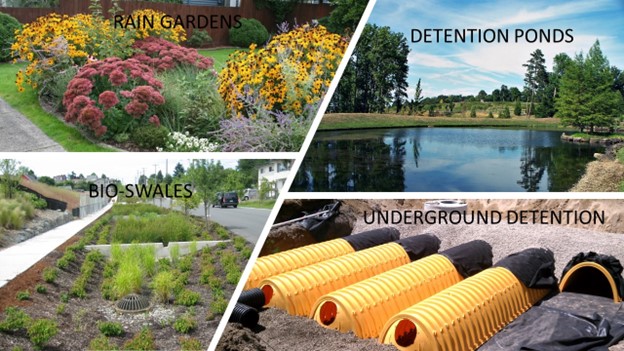Post Construction Site Runoff Control
Post-Construction Site Runoff
The intent of post construction pollution controls is to reduce the amount of pollutants generated by a site once construction has been completed. Depending on the final land use, there are many different pollutants that can be carried into storm water runoff once a site has been developed. Typical pollutants and their impacts may include the following:
- Nutrients – these are typically generated by lawn fertilizers, agricultural applications, failures in sanitary sewers, or septic tank effluents. Excessive amounts of nutrients can lead to reduced oxygen levels in receiving water. They can also cause excessive algae growth.
- Bacteria – these can result from pet waste, sanitary sewer failures, and septic tank effluent. Bacteria present health hazards to humans, so they can prevent recreational use of waterways.
- Automotive Fluids – these can leak out of vehicles onto public streets, or they can enter waterways because of improper disposal or illegal dumping of used fluids. These fluids can be unhealthy or deadly for aquatic life and humans.
- Metals – these are typically generated by automobiles and industrial areas. According to the IDEM “Storm Water Quality Manual,” these pollutants are long lived in the environment, they can often work their way into the food chain and are passed from one organism to another, and they can have toxic effects when built up in a system over time.
- Road Salt – the source of salt can be public roads, parking lots, and/or home applications. High concentrations of this, such as what can be found in snow melt, can be lethal to aquatic organisms in high concentrations.
- Miscellaneous Chemicals – these can result from pesticide and herbicide applications, accidental spills, vehicles, and illegal dumping. Depending upon the specific chemical, they can be lethal to aquatic organisms.
To attempt to reduce post construction pollution, the MS4GP requires the development and implementation of post-construction pollution controls. The MS4GP also mandated that Vanderburgh County develop a local ordinance that requires post construction pollution prevention plans and best management practices (BMPs). These local regulations can be found in Chapter 13.05 of the County Code of Ordinances.
What is a Post-Construction BMP?
BMPs come in various sizes and shapes, but some of the most recognizable are below:

Every post construction BMP will require maintenance for it to be effective in removing pollutants. Due to the limited resources of Vanderburgh County maintenance crews, owners are required to submit operation and maintenance plans during construction and must maintain the structure for its life.
For suggestions regarding appropriate post construction BMPs, please refer to Chapter 8 of the “Indiana Storm Water Quality Manual.”


